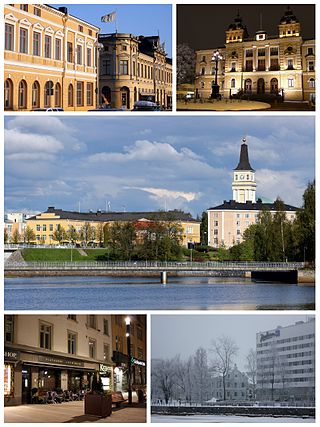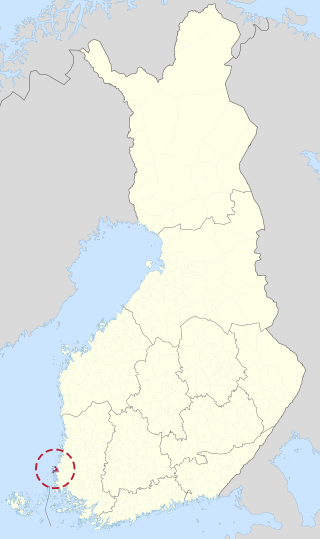
Kokkola is a town in Finland and the regional capital of Central Ostrobothnia. It is located on the west coast of the country, on the Gulf of Bothnia. The population of Kokkola is approximately 48,000, while the sub-region has a population of approximately 54,000. It is the 22nd most populous municipality in Finland, and the 20th most populous urban area in the country.

Hanko is a town in Finland, located in the southern coast of the country. Hanko is situated in the western part of the Uusimaa region. The population of Hanko is approximately 8,000, while the sub-region has a population of approximately 40,000. It is the 121st most populous municipality in Finland.

Oulu is a city in Finland and the regional capital of North Ostrobothnia. It is located on the northwestern coast of the country at the mouth of the River Oulu. The population of Oulu is approximately 216,000, while the sub-region has a population of approximately 264,000. It is the 5th most populous municipality in Finland, and the fourth most populous urban area in the country. Oulu is also the most populous city in Northern Finland.

Mariehamn is the capital of Åland, an autonomous territory under Finnish sovereignty. Mariehamn is the seat of the Government and Parliament of Åland, and 40% of the population of Åland live in the city. It is mostly surrounded by Jomala, the second-largest municipality in Åland in terms of population; to the east, it is bordered by Lemland. Like the rest of Åland, Mariehamn is unilingually Swedish-speaking and around 82% of the inhabitants speak it as their native language.

Jakobstad is a town in Finland, located on the west coast of the country. Jakobstad is situated in Ostrobothnia, along the Gulf of Bothnia. The population of Jakobstad is approximately 19,000, while the sub-region has a population of approximately 50,000. It is the 59th most populous municipality in Finland.

Enontekiö is a municipality in the Finnish part of Lapland with approximately 1,800 inhabitants. It is situated in the outermost northwest of the country and occupies a large and very sparsely populated area of about 8,400 square kilometres (3,200 sq mi) between the Swedish and Norwegian border. Finland's highest point, the Halti fell, with a height of 1,324 metres (4,344 ft) above the mean sea level, is situated in the north of Enontekiö. The municipality shares borders with regions of Sweden and Norway that encompass the Scandinavian Mountains. The administrative centre of Enontekiö is the village of Hetta. About one fifth of the community's population are Sami people. Enontekiö's main industries are tourism and reindeer husbandry.

Haukipudas is a town and former municipality of Finland. It was located in the province of Oulu and is part of the Northern Ostrobothnia region. Its shore runs along the Gulf of Bothnia, with the river Kiiminkijoki running through the province. Along with Kiiminki, Oulunsalo and Yli-Ii municipalities it was merged with the city of Oulu on 1 January 2013.

Kuusamo is a town and municipality in Finland. It is located in Koillismaa, the northeastern part of the Northern Ostrobothnia region. The municipality has a population of 14,813 and covers an area of 5,808.92 square kilometres (2,242.84 sq mi) of which 830.81 km2 (320.78 sq mi) is water. The population density is 2.98 inhabitants per square kilometre (7.7/sq mi).

Korsholm is a municipality in Finland, located on the west coast of the country. Korsholm is situated in Ostrobothnia, along the Gulf of Bothnia. The population of Korsholm is approximately 20,000, while the sub-region has a population of approximately 111,000. It is the 55th most populous municipality in Finland.

The Archipelago Sea is a part of the Baltic Sea between the Gulf of Bothnia, the Gulf of Finland and the Sea of Åland, within Finnish territorial waters. By some definitions it contains the largest archipelago in the world by the number of islands, estimated at around 50,000, although many of the islands are very small and tightly clustered.

The Bothnian Bay or Bay of Bothnia is the northernmost part of the Gulf of Bothnia, which is in turn the northern part of the Baltic Sea. The land holding the bay is still rising after the weight of ice-age glaciers has been removed, and within 2,000 years the bay will be a large freshwater lake since its link to the south Kvarken is mostly less than 20 metres (66 ft) deep. The bay today is fed by several large rivers, and is relatively unaffected by tides, so has low salinity. It freezes over each year for up to six months. Compared to other parts of the Baltic, it has little plant or animal life.

Marjaniemi Lighthouse is a lighthouse located in the village of Marjaniemi at the westernmost point of Hailuoto island on the Gulf of Bothnia. The lighthouse is located approximately 50 kilometres (31 mi) west of Oulu. The lighthouse was designed by Axel Hampus Dalström as his fourth lighthouse and it was first lit in 1872.

The Keskiniemi beacon tower, often referred to as the Karvo beacon tower, is a historic daymark located on a promontory of Keskiniemi in the northwestern part of Hailuoto island in the Gulf of Bothnia in Finland. The tower was built in 1858 to alert the vessels about sandbars reaching northwest from the site. It is the oldest surviving navigational aid on Hailuoto island. The tower has structural similarities with the Härkmeri beacon tower built in 1857.

Larsmo is a municipality in Finland, located on the west coast of the country. Larsmo is situated in Ostrobothnia, along the Gulf of Bothnia. The population of Larsmo is approximately 6,000, while the sub-region has a population of approximately 50,000. It is the 154th most populous municipality in Finland.
Kellon Kraaseli is an island in the Finnish sector of the Bay of Bothnia.

Finnish regional road 816 or Hailuoto Road is a Finnish road between the Kempele municipality and the Hailuoto Island. The length of the road is 56 kilometres (35 mi) which includes a 6.9-kilometre (4.3 mi) ferry connection between mainland and the Hailuoto Island.

Pyhämaa is a village and a former municipality of Finland in the former Turku and Pori Province, now in the Finland Proper region. It was consolidated with the town of Uusikaupunki in 1974.

The Hailuoto Church is the 1972 church located on the Hailuoto island in North Ostrobothnia, Finland. The church was designed by architects Irma and Matti Aaltonen. It is built of reinforced concrete and has a capacity of about 200–300. The church was built to replace the former church from 1620, which was destroyed by fire in 1968. A natural forest cemetery is located near the church.
























